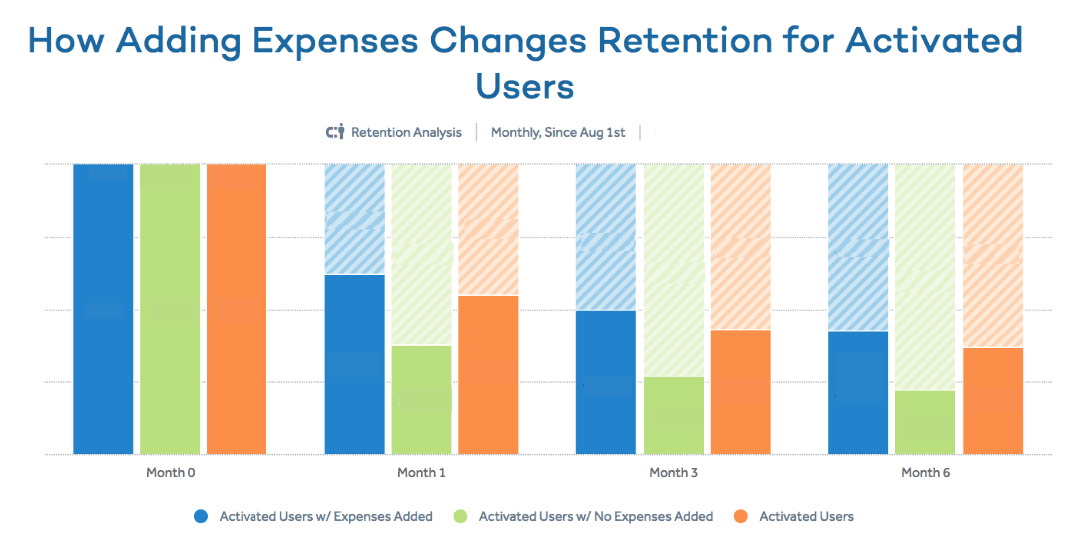Define These Two Inputs for Your Retention Rate Formula
Identifying the two inputs of retention will allow you to correctly choose the right retention rate formula for your company.
Browse by category
Retention rate is a key metric in determining the health of your product. It tells you how many of your users are finding enough value to come back a second time. But just knowing that a user came back to your platform doesn’t help you make a better product. By also factoring in the specific actions that align with your core value proposition and the time it takes for users to complete them, your retention rate formula is a stronger indicator of how much users value your product.
The Generic Retention Rate Formula Is Just a Starting Point
Retention rate is the percentage of users who come back to your product or service over time. Generally speaking, retention rate can be calculated as:
Number of active users at end of period / Number of active users at start of period
But that’s just the tip of the iceberg. The time period you use in your retention rate formula depends on the method you use to measure retention: N Day Retention, Bracketed Retention, or Unbounded Retention. And what determines the method you use? It’s based on how users engage with your product and what cadence of usage you expect from customers.
In addition, you can get more specific than just measuring “active” users. You can drill into activity by measuring Current User Retention, New User Retention, or Resurrected User Retention.
For your retention rate to be meaningful, you need to drill down into each of these factors. To build a retention rate formula that works for your business, start by defining two things:
- The action, or critical event, you want users to take
- The usage interval, or the timeframe in which you would expect those users to take that action
Input 1: The Action You Want Users To Take
To understand what it means to be a retained user for your business, you must first identify your product’s critical event—a specific action you most want users to perform. This action should closely match the values and goals of your company while also still providing value to the user. Most companies have one critical event for each product offering.
Different industries measure various events. Mobile game designers want users to advance through a game, while grocery-delivery companies are hoping users place an order.
The financial platform Dave identified that their critical event was adding recurring expenses to the account. By reworking their onboarding to emphasize this step, they saw retention improve significantly. Users who added expenses during onboarding were 5.7 times more likely to be using the app three months later.

To determine what action is critical enough to include in your retention rate formula, ask yourself these questions:
- What are your product offerings?
- What value do your users get from those products (not just the value you want them to get)?
- What action would make you the most excited if every user started doing it?
- What action do you most want users to perform?
By factoring in your critical event, you have a retention rate formula that more accurately reflects the users who you want to stay on your platform.
Input 2: The Timeframe for Users to Take That Action
The second important factor in your retention rate formula is the timeframe in which your users complete the critical action you’ve identified. This usage interval will vary by the critical event. You would expect users of a vacation booking site to reserve a getaway twice a year. But if the users of your meditation app logged in only a few times a year, you’d be concerned.
For your retention rate formula to work, you need to find a usage interval—the time it takes for most users to take that critical action a second time—that makes the most sense for your business. To determine this timeframe, use this four-step framework:
- Create a behavioral cohort of everyone who has completed your critical event within a specific timeframe. Make that timeframe longer than you would expect people to naturally return. We suggest 60 days as a starting point.
- Record how long it took for users to complete the action a second time.
- Create a graph indicating when people completed the action a second time so you can easily see the distribution of users over time.
- Your product usage interval is when 80% of users have completed the action a second time.
Use these worksheets to determine your critical event and product usage interval.
Once you’ve identified your usage interval, you can use that information to put your retention rate formula into action. There are three ways to calculate your retention rate over time:
- N-Day Retention: The percentage of users who perform your critical event on a specific day. This works well when your usage interval is a consistent and specific timeframe, such as a fitness tracking app that wants users to log in daily.
- Unbounded Retention: The percentage of users who perform your critical action on a specific day or later. This works well when your usage interval is a little sporadic. A grocery delivery app, for example, may use this formula to see who placed an order after their first week of using the product.
- Bracket Retention: The percentage of users who perform your critical action within a custom timeframe. Bracket Retention works well for usage intervals that don’t really fit into the other two buckets, such as a nonperishable home-goods ecommerce site, where customers might stock up every 10 to 14 days.
If you aren’t sure which calculation fits your business, try a few different methods. With multiple retention insights, you’ll have an accurate picture of how your product offering is performing.
A Retention Rate Formula That Performs for You
It isn’t enough to have users come back to your product and perform any action. You want them to return and complete high-value activities—the ones that signal these users understand your product’s value and are here to stay. Adapt your retention rate formula to incorporate this critical event. You’ll have a stronger sense of how well your product is attracting users and what you can do to improve it for your audience.

Nate Franklin
Former Director, Product Marketing, Amplitude
Nate Franklin is a former director of product marketing at Amplitude. As a former product manager and self-declared product nerd, he's often asking, "ok, so what is our goal?"
More from Nate




